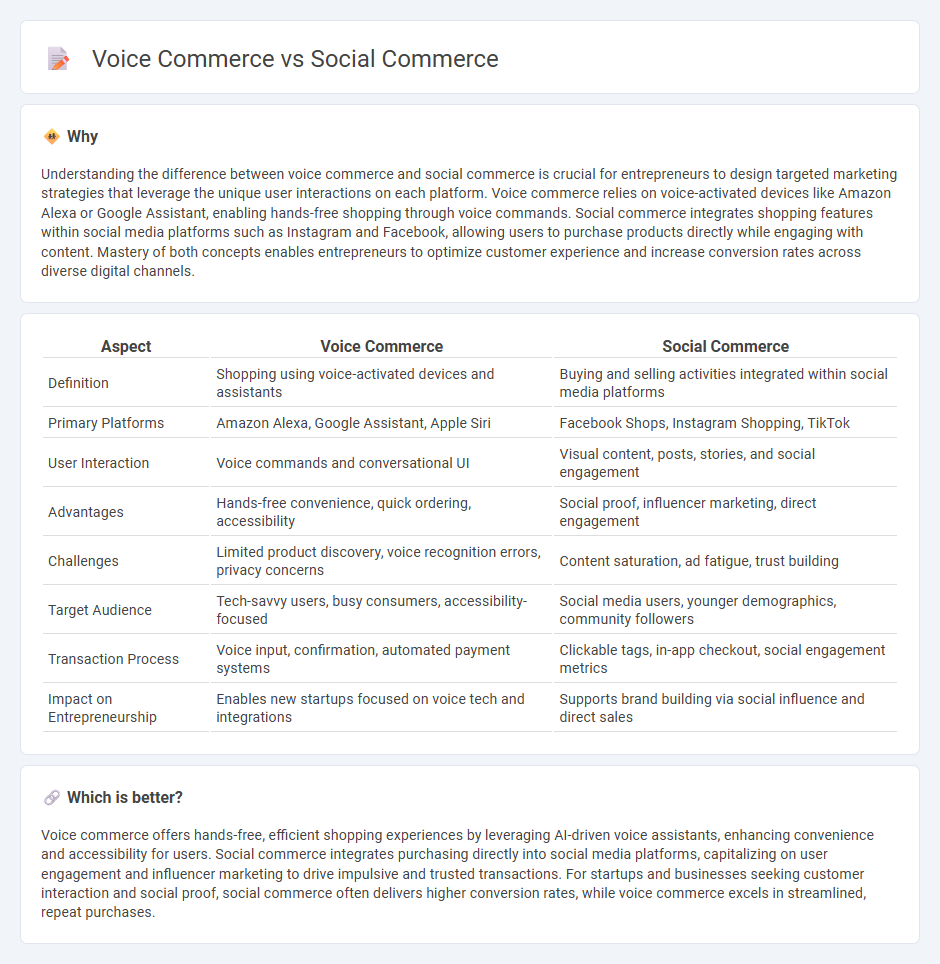
Voice commerce leverages voice recognition technology to facilitate seamless shopping experiences through devices like smart speakers and virtual assistants, enabling hands-free transactions. Social commerce integrates e-commerce directly into social media platforms, allowing users to discover and purchase products within apps such as Instagram and Facebook. Explore the distinct advantages and trends driving the future of voice commerce versus social commerce to enhance your entrepreneurial strategies.
Why it is important
Understanding the difference between voice commerce and social commerce is crucial for entrepreneurs to design targeted marketing strategies that leverage the unique user interactions on each platform. Voice commerce relies on voice-activated devices like Amazon Alexa or Google Assistant, enabling hands-free shopping through voice commands. Social commerce integrates shopping features within social media platforms such as Instagram and Facebook, allowing users to purchase products directly while engaging with content. Mastery of both concepts enables entrepreneurs to optimize customer experience and increase conversion rates across diverse digital channels.
Comparison Table
| Aspect | Voice Commerce | Social Commerce |
|---|---|---|
| Definition | Shopping using voice-activated devices and assistants | Buying and selling activities integrated within social media platforms |
| Primary Platforms | Amazon Alexa, Google Assistant, Apple Siri | Facebook Shops, Instagram Shopping, TikTok |
| User Interaction | Voice commands and conversational UI | Visual content, posts, stories, and social engagement |
| Advantages | Hands-free convenience, quick ordering, accessibility | Social proof, influencer marketing, direct engagement |
| Challenges | Limited product discovery, voice recognition errors, privacy concerns | Content saturation, ad fatigue, trust building |
| Target Audience | Tech-savvy users, busy consumers, accessibility-focused | Social media users, younger demographics, community followers |
| Transaction Process | Voice input, confirmation, automated payment systems | Clickable tags, in-app checkout, social engagement metrics |
| Impact on Entrepreneurship | Enables new startups focused on voice tech and integrations | Supports brand building via social influence and direct sales |
Which is better?
Voice commerce offers hands-free, efficient shopping experiences by leveraging AI-driven voice assistants, enhancing convenience and accessibility for users. Social commerce integrates purchasing directly into social media platforms, capitalizing on user engagement and influencer marketing to drive impulsive and trusted transactions. For startups and businesses seeking customer interaction and social proof, social commerce often delivers higher conversion rates, while voice commerce excels in streamlined, repeat purchases.
Connection
Voice commerce leverages voice-activated devices to facilitate seamless purchasing experiences, while social commerce integrates shopping features directly into social media platforms. Both forms of commerce enhance customer engagement by streamlining the buying process and utilizing conversational interactions for personalized recommendations. The convergence of voice commerce and social commerce drives higher conversion rates by combining voice-enabled search with social network influence.
Key Terms
Social media platforms
Social commerce leverages social media platforms like Instagram, Facebook, and TikTok to facilitate seamless shopping experiences through in-app product tags, shoppable posts, and live video sales. Voice commerce relies on voice-activated assistants such as Amazon Alexa, Google Assistant, and Apple Siri to enable hands-free purchases via voice commands. Explore the unique features and growth potential of social and voice commerce platforms to optimize your digital sales strategy.
Conversational AI
Social commerce leverages platforms like Facebook, Instagram, and TikTok to enable seamless shopping through interactive content and user-generated reviews, enhancing customer engagement. Voice commerce utilizes conversational AI technologies such as Alexa, Google Assistant, and Siri to facilitate hands-free purchasing and personalized shopping experiences via voice commands. Explore how integrating conversational AI in both social and voice commerce channels can revolutionize customer interactions and boost sales.
User engagement
Social commerce leverages interactive platforms like Instagram and TikTok to drive user engagement through direct product discovery and peer recommendations, enhancing authenticity and trust. Voice commerce utilizes smart speakers and voice assistants such as Amazon Alexa and Google Assistant to simplify purchasing with hands-free, conversational interfaces that cater to convenience and speed. Explore how these evolving technologies transform shopping experiences by deepening user interaction and satisfaction.
Source and External Links
Social commerce - Social commerce involves using social networks to conduct e-commerce transactions entirely within social media platforms, from product browsing to checkout.
What is social commerce? - Social commerce is a rapidly growing branch of e-commerce enabling retailers to market and sell products directly on social apps like Facebook, TikTok, and Instagram, leveraging social interactions and data-driven personalized advertising.
What Is Social Commerce? Tips and Trends - Social commerce provides businesses a fast, convenient way to reach customers by engaging them on social media during micromoments, driving sales with personalized content, influencer marketing, and seamless buying experiences.
 dowidth.com
dowidth.com